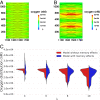Abnormal morphology biases hematocrit distribution in tumor vasculature and contributes to heterogeneity in tissue oxygenation
- PMID: 33109723
- PMCID: PMC7668105
- DOI: 10.1073/pnas.2007770117
Abnormal morphology biases hematocrit distribution in tumor vasculature and contributes to heterogeneity in tissue oxygenation
Abstract
Oxygen heterogeneity in solid tumors is recognized as a limiting factor for therapeutic efficacy. This heterogeneity arises from the abnormal vascular structure of the tumor, but the precise mechanisms linking abnormal structure and compromised oxygen transport are only partially understood. In this paper, we investigate the role that red blood cell (RBC) transport plays in establishing oxygen heterogeneity in tumor tissue. We focus on heterogeneity driven by network effects, which are challenging to observe experimentally due to the reduced fields of view typically considered. Motivated by our findings of abnormal vascular patterns linked to deviations from current RBC transport theory, we calculated average vessel lengths [Formula: see text] and diameters [Formula: see text] from tumor allografts of three cancer cell lines and observed a substantial reduction in the ratio [Formula: see text] compared to physiological conditions. Mathematical modeling reveals that small values of the ratio λ (i.e., [Formula: see text]) can bias hematocrit distribution in tumor vascular networks and drive heterogeneous oxygenation of tumor tissue. Finally, we show an increase in the value of λ in tumor vascular networks following treatment with the antiangiogenic cancer agent DC101. Based on our findings, we propose λ as an effective way of monitoring the efficacy of antiangiogenic agents and as a proxy measure of perfusion and oxygenation in tumor tissue undergoing antiangiogenic treatment.
Keywords: anti-angiogenic agents; hematocrit dynamics; mathematical modelling; oxygen heterogeneity; tumor vasculature.
Copyright © 2020 the Author(s). Published by PNAS.
Conflict of interest statement
The authors declare no competing interest.
Figures





References
-
- Gray L. H., Conger A. D., Ebert M., Hornsey S., Scott O. C. A., The concentration of oxygen dissolved in tissues at the time of irradiation as a factor in radiotherapy. Br. J. Radiol. 26, 638–648 (1953). - PubMed
-
- Harris A. L., Hypoxia—A key regulatory factor in tumour growth. Nat. Rev. Canc. 2, 38–47 (2002). - PubMed

